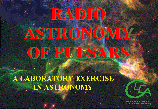

 |
Required SoftwareThis is a zip file that contains an .exe file that will install itself when you run it on your computer. |
||
| The software for this exercise
presents students with a radio telescope whose default operating characteristics
(beam width, receiver noise, steerability) can be set by the instructor.
Students can point the telescope at a source in the sky, viewing the output
of the radio receiver on a graphic display that resembles a digital oscilloscope.
The receiver can be tuned to a range of frequencies between 400 and 1400
Mhz, and additional independently tunable receivers (up to 3 total) can
be displayed on the screen. Gain and sweep time of the display can be adjusted
to optimize the appearance of the signal. Data from each receiver can be
saved for later analysis on a versatile measuring screen. PC's with sound
cards can also "listen" to an audio version of the signal
Background and instrument noise are simulated, along with noise intrinsic to the source. Pulsar spin-down rates are also included. The student manual describes an exercise in which students first acquaint themselves with the operation of the radio telescope. They then measure the signals from several pulsars at various frequencies, learning about the appearance of pulsar signals, the strength and period of the signal as a function of frequency, and the relation between pulsar period and age of the pulsar. Finally they view the signal from a pulsar at three different frequencies, using the delay in arrival times due to interstellar dispersion to estimate the distance to the pulsar. The radio telescope has optional features which can be used for additional labs. It can be operated in transit or trackingmode to discover pulsars. The date of the observations can be set by the user so that, with care, pulsar spin-down rates can be measured if obsevations on two dates a few years apart are observed.The beam width of the instrument can be measured by letting sources drift through it with the tracking off. Data for over 500 pulsars are supplied, and, at the instructor's discretion, the positions of the pulsars can be displayed on a sky map, along with the position in which the radio telescope is pointing. [AVAILABLE FOR WINDOWS ONLY] |